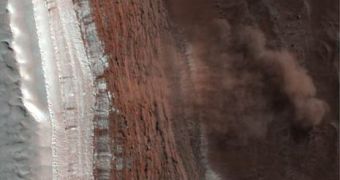The unique event has been observed by NASA's Mars Reconnaissance Orbiter with the High Resolution Imaging Experiment, HiRISE for short, on February 19, during a scan of a region of the Red Planet's surface near the north pole. This is the first image of an avalanche ever surprised on Mars! The image released yesterday by NASA clearly shows how a cloud front is moving away from the base of a slope covered with a mix of dust and ice.
The discovery has been made by Ingrid Daubar Spitale from the University of Arizona, which is also a mission scientist from the HiRISE mission on board the Mars Reconnaissance Orbiter, while looking through the images taken by the HiRISE camera. The MRO was engaged in studying the season changes which take place on Mars when HiRISE caught the cascading mix of ice and dust on film.
The data collected by the MRO reveals what seems to be the image of a small feature in the middle of a strip 6 kilometers wide and 60 kilometers long, at a latitude of 84 degrees north, made out of reddish layers with high concentrations of ice rising more than 700 meters into the air. As odd as it might seem, Mars' polar caps are actually covered with ice, which basically means that, at one point in time, it had to snow to deposit it. In fact, there might be a possibility more ice to exist in the lower region of the slope, as a result of previous avalanches.
Patrick Russle from the University of Berne, another HiRISE collaborator says that the fallen blocks of ice should shrink in size as water evaporates from them, proving that indeed they are made of water ice. Similar events may help the future understanding of the clime on Mars, and specially its water cycle. Ingrid Spitale says that she was rather surprised when she saw how dynamic Mars actually is, considering the fact that not much has changed on the surface of the planet in more than one million years.
It is currently unknown what determined the landslide, but the HiRISE team argues that such naturally occurring events take place much more frequently than previously believed. Russell believes that there might be a possibility that avalanches on Mars to be only restricted to the spring season, a possibility which would also provide with an explanation why they haven't been observed in the past by the previous Martian probes.

 14 DAY TRIAL //
14 DAY TRIAL //